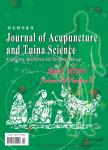Effects of acupuncture on neuro-electrophysiological activities in hippocampal CAI and CA3 areas of rats with post-traumatic stress disorder
针刺对创伤后应激障碍模型大鼠海马CAI和CA3区神经电生理活动的影响作者机构:Gansu University of Chinese Medicine Lanzhou 730000 China Postdoctoral Research Station of Traditional Chinese Medicine Gansu University of Chinese Medicine Lanzhou 730000 China Gansu Provincial Hospital of Traditional Chinese Medicine Lanzhou 730050 China
出 版 物:《Journal of Acupuncture and Tuina Science》 (针灸推拿医学(英文版))
年 卷 期:2019年第17卷第2期
页 面:67-73页
核心收录:
学科分类:1006[医学-中西医结合] 100602[医学-中西医结合临床] 10[医学]
基 金:中国博士启科学基金第62批面上项目(No.2017M623269) 2014年度国家自然科学基金地区项目(No.81460744) 2013年度甘肃省自然科学研究基金计划项目(No. 1308RJZA150)
主 题:Acupuncture Therapy Point, Baihui (GV 20) Point, Neiguan (PC 6) Point, Shenmen (HT 7) Point, Taichong (LR 3) Stress Disorders, Post-traumatic Electrophysiology Rats
摘 要:Objective: To observe the effects of acupuncture on the characteristics of neuro-electrophysiological activity in hippocampal CAI and CA3 areas of rats with post-traumatic stress disorder (PTSD). Methods: Fifty Sprague-Dawley (SD) rats were randomly divided into a blank group, a model group, a grasping group, a Western medicine group and an acupuncture group, with 10 rats in each group. Except for the blank group, rats in the other 4 groups all received the combined stress modeling method. Rats in the Western medicine group were intragastrically administrated with paroxetine hydrochloride, those in the acupuncture group received acupuncture intervention, those in the grasping group received grasping fixation, and those in the model group and the blank group did not receive any in terve ntions. After 14 d of in terve ntion, the interspike in terval (ISI) and power spectral den sities (PSD) were an a lyzed and mapped by in vivo multiple channels to record the neuron clusters discharge in the hippocampal CAI and CA3 areas. Results: Compared with the blank group, ISI was proIonged in the CAI and CA3 areas of the model group and the grasping group, and the concentrated PSD distribution area moved down (Pv0.05 or P0.05). Conclusion: Both acupuncture and paroxetine hydrochloride can significantly regulate the neuro-electrophysiology activity of hippocampal CAI and CA3 areas in PTSD rats, which may be one of the mechanisms of acupuncture intervention to promote PTSD recovery.



